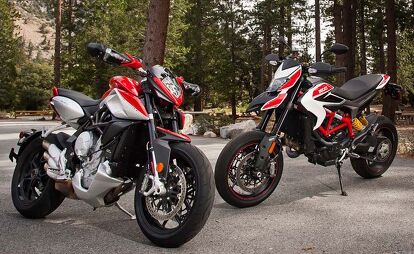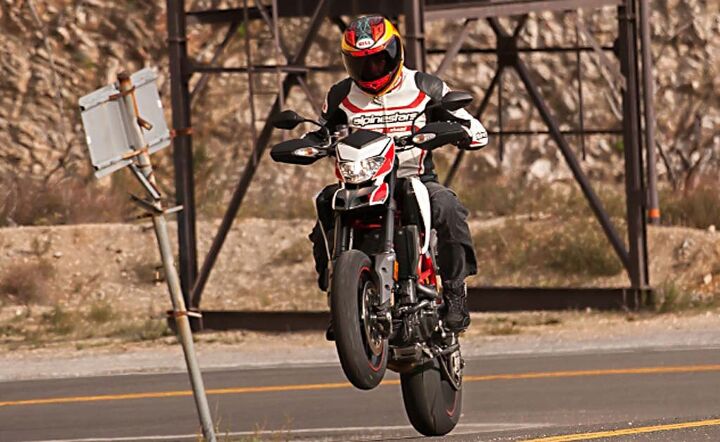Mega Motard Shootout: 2014 Ducati Hypermotard SP Vs. MV Agusta Rivale + Video

Let's... Get... MOtarded!
By Tom Roderick and Troy Siahaan
The coolest thing about the Ducati Hypermotard SP and MV Agusta Rivale is that both bikes are built for the sole purpose of having a damn good time. Where other motorcycles must perform dutifully to their design parameters such as sport-touring or dual-purposing, these two party animals have no such restrictions.
Party animals have their drawbacks, though, the worst being their proclivity for convincing you to do really stupid things at incredibly inappropriate times. For the record, no cute, furry four-leggers were harmed during this shootout, but laws were intentionally, repeatedly flouted, ignored and broken. No, seriously officer, it’s our job.
For the unretired class clown there are no better motorcycles than these two ’tards. But which is the preferred partner-in-crime?
Ducati arguably opened the doors to the beefed-up-motard-for-the-street look with the original Hypermotard – Ruben Xaus backing it in, on his knee, while giving a thumbs-up is unforgettable! If the first-gen Hyper was a public nuisance, the revised, Hypermotard 2.0 is more civilized and accommodating, but will still get you in plenty of trouble.
The late-to-the-game MV Agusta Rivale is clearly borrowing some design cues from its rivals in Bologna. But in the couldn’t-be-more-different category is the marque’s three-cylinder calling card. The 798cc Triple is an engine MV could wedge into a riding lawn mower, and we’d love it.
With the Rivale, its stubby front end, slim mid-section, and even its fold-out mirrors mimic those on the first generation Hypermotard. With such a clear imitation of the Hypermotard style, we found it only right to pit these cross-town rivals together in a battle for Italian mega-tard supremacy.
Hitting The Ground Running
Detailed specs and riding impressions of both the Hyper and the Rivale can be found in the links above. For this test, we’re focusing on more pertinent differences between the two ’tards, and more importantly, the seat-of-the-pants impressions on how each bike stacks up against the other. The judges for this contest include your trusty Ural editor Tom Roderick, and Asians-can’t-be-Wolverine editor Troy Siahaan.
The most obvious difference between the Duc and MV is in the engine bay. It’s Twin vs. Triple, torque vs. horsepower, genialness vs. freneticism. Not to say the Hyper’s engine is sluggish, but when compared to the quick-revving tre pistoni in the MV, the L-Twin is certainly slower in reaching its lower redline.
The Duc’s slightly higher torque at lower revs results in a minimal advantage when exiting slow corners, but that advantage quickly dissolves as the higher horsepower and shorter gearing of the Rivale assert themselves.
“A skilled rider can keep up with his buddy in the tight stuff if you’re on the Hyper and he on the Rivale, but once the MV has a chance to stretch its legs, it’s gone,” says Siahaan.
Yeah, MV designed a highly-stylized ’tard, but its engine is all sportbike and there’s no masking the fact when riding these two bikes together. As good as Ducati’s 821cc Twin is, it’s no match for the Rivale’s Triple and its newfound fueling. We should mention, however, that there remains a slight abruptness from the Rivale while in its most aggressive ride mode.
In the handling department, the two are split between nimbleness and stability. The Rivale, with its short wheelbase (55.5 inches vs. 59.3 inches) and resultant quick transitioning, flicks from corner to corner like a hummingbird in an arboretum. The Duc has greater cornering stability and a torque advantage during corner exits, but it’s not enough to keep the Rivale at bay.
“Both bikes handle very well but are entirely different,” Siahaan observes, “and it’s here where I can’t pick between the two. The MV is quick, frantic, sharp. Meanwhile, the Ducati isn’t quite as quick to turn, but is very stable once leaned over. The forged-rather-then-cast Marchesini wheels of the Duc surely help its flickability. So in the handling department, I’m calling a stalemate.”
View more pictures in our gallery
Both editors agreed the brakes on the Ducati were the better of the two, mainly because of their linear response. Brembos adorn both bikes, so scrubbing speed isn’t a problem for either. But much like our F3 800 test bike sampled in our Middleweight Supersport test, the Rivale’s pads seem overly aggressive. Because the Hyper’s were easier to modulate, it gets the nod. It’s worth noting our test Rivale didn’t have ABS, but the option is coming later this year. It bumps the MV’s price to $15,798 – $800 more than the Ducati.
“The extra travel in the fork makes the harsh initial bite of the Rivale’s brakes even more pronounced as the front end dives further than the F3’s under hard braking,” says Roderick. “The Duc’s, by comparison, ease into the meat of their braking force without the undue harshness.”
Neither bike puts the rider in a crouched over sportbike position, with a rider siting practically upright on both mounts. Still, that doesn’t equate to long-distance comfort, and it’s no surprise neither makes a good choice for freeway slabs. Wind protection is non-existent, turning the rider into a sail at highway speeds, but we really couldn’t get over the MV’s saddle.
Says Tom: “The Rivale’s plank it calls a seat got uncomfortable before reaching the end of the driveway, while the Hypermotard’s sculpted butt comforter was immeasurably better during rides lasting more than 15 seconds.” Yes, the Ducati’s seat was better padded, but it’s sculpted in a way that doesn’t allow the rider to move much.
Which Is The Most ’Tarded?
We’ve established neither bike enjoys going in a straight line for very long. Fine, we’ll take ’em to the twisties and really have some fun. Sounds well and good until the Rivale runs out of gas after 80 miles. With only a 3.4-gallon gas tank, this is exactly the scenario we ran into during our testing. MV Agusta may have finally fixed the terrible fueling we’ve complained about before, but the Rivale’s thirst can really put a quick end to an otherwise action-packed day. We got a consistent 31 mpg in average riding, but you’re still keeping your eyes wide open for a gas station well before the 100-mile mark on the tripmeter.
Unfortunately for MV, this left a sour taste in our mouths. “I’ve never felt compelled to push a press bike off a cliff, but running out of fuel and leaving us stranded with only 80 miles on the clock had me hating the bike that just moments before I was adoring,” Tom beefs.
| 2014 Mega-Motard Scorecard | ||
|---|---|---|
| Category | Ducati Hypermotard SP | MV Agusta Rivale |
| Price | 10.0 | 10.0 |
| Weight | 10.0 | 10.0 |
| Engine | 18.6 | 19.4 |
| Transmission/Clutch | 8.2 | 9.1 |
| Handling | 9.0 | 9.0 |
| Brakes | 8.8 | 8.4 |
| Suspension | 9.0 | 9.0 |
| Technologies | 8.9 | 9.3 |
| Instruments | 8.1 | 8.5 |
| Ergonomics/Comfort | 7.2 | 6.5 |
| Luggage/Storage | 10 | 10 |
| Appearance | 9.0 | 8.8 |
| Cool Factor | 8.5 | 10 |
| Grin Factor | 9.0 | 9.6 |
| Overall Score | 88.1% | 90.4% |
| All scores have a maximum of 10 except Engine which is scored out of 20. | ||
So where do we go from here? Up to this point, we had been having so much fun with the MV that it was our runaway winner. But running out of gas because of a small gas tank is difficult to excuse. It’s times like this where the MO scorecard becomes especially useful. The final tally was incredibly close, with the Rivale taking six of our subjective categories to the Hyper’s three. The Ducati, priced at $14,995, is only three bucks cheaper than the Rivale.
Ultimately, the MV Agusta steals the show in this test, but only by the narrowest of margins. Its limited range was almost a deal breaker, but in the category that counts the most – how big a smile it puts on our faces – we couldn’t deny we simply liked it more.
Tom sums up our thoughts best. “This was a very close shootout for me, with the Rivale winning on the ScoreCard by less than two points. Its limited range and uncomfortable seat hurt the Rivale’s scores, but it managed to squeak out the win.”
Editor’s Note: The Rivale squeaked out a win despite its disappointing fuel range and its minimally comfortable seat. We figure that someone in the market for this type of bike likely isn’t much interested in long-haul comfort or range and instead puts more value in the smiles-per-mile quotient, which the Rivale delivers in spades. – Kevin Duke, Editor-In-Chief

Motorcycle.com presents an unrivaled combination of bike reviews and news written by industry experts
More by Motorcycle.com Staff


















































Comments
Join the conversation
Where is the Aprilia Dorsoduro?
Forgive me for being late to the party but this just showed up on twitter from one of those sites that just trawl for other people's content to display on their own sites.
I am baffled as to why you made this comparison. The Hypermotard is a dual-sport, that's how Ducati describe and market it. You might argue it's more motard than tourer but the hyperstrada version balances that.
The MV? It's a streetfighter, look at it.
The guys in the video even explain exactly how different these two bikes are.
I have a few Ducatis in the garage here, let me know when you want to compare any of them to a Harley Davidson. Baffling.
And dear America, nobody at the factory, nobody in Bologna, nobody in Italy, Nobody in Europe for that matter, ever calls a Ducati a 'duck'. Please don't do that. ( it's not doo-cart-ee either but that's another story )